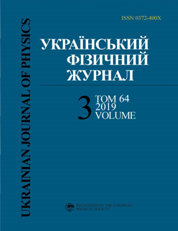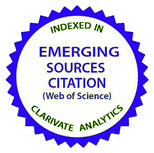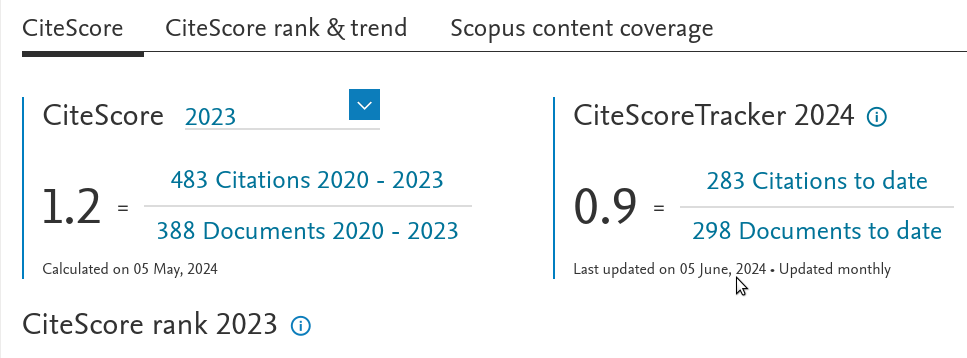Сферично-симетричні конфігурації у ЗТВ у присутності лінійного масивного скалярного поля: розділення розподілу колових орбіт пробних тіл
DOI:
https://doi.org/10.15407/ujpe64.3.189Ключові слова:
-Анотація
Дослiджено статичнi сферично-симетричнi конфiгурацiї в присутностi лiнiйних масивних скалярних полiв в ЗТВ. Розглянуто статичнi асимптотично-плоскi розв’язки рiвнянь Ейнштейна. Кожний розв’язок фiксується масою конфiгурацiї i параметром, що характеризує iнтенсивнiсть поля, якi визначаються на просторовiй нескiнченностi. Метричнi коефiцiєнти i вигляд скалярного поля для конкретної конфiгурацiї отримано чисельно; на цiй основi дослiджено часоподiбнi геодезичнi, що описують рух пробних частинок. Основна увага придiлена розподiлу стiйких колових орбiт (СКО) пробних частинок навколо конфiгурацiї. Знайдено, що для множини параметрiв конфiгурацiї iснують двi незв’язнi областi СКО, якi роздiленi кiльцевою областю, де СКО не iснують.
Посилання
B. Novosyadlyi, V. Pelykh, Yu. Shtanov, A. Zhuk. Dark Energy and Dark Matter of the Universe. Ed. by V. Shulga (Kiev, Akademperiodyka, 2013), Vol. 1 [ISBN: 978-966-360-240-0].
A. Linde. Inflationary Cosmology after Planck 2013. (2014) arXiv:1402.0526 [hep-th].
S. Nojiri, S.D. Odintsov. Unified cosmic history in modified gravity: From F(R) theory to Lorentz non-invariant models. Phys. Rept. 505, 59 (2011). https://doi.org/10.1016/j.physrep.2011.04.001
S. Nojiri, S.D. Odintsov, V.K. Oikonomou. Modified gravity theories on a nutshell: Inflation, bounce and late-time evolution. Phys. Rept. 692, 1 (2017). https://doi.org/10.1016/j.physrep.2017.06.001
V. Sahni. Dark matter and dark energy. Lect. Notes Phys. 653, 141 (2004).
E.J. Copeland, M. Sami, S. Tsujikawa. Dynamics of dark energy. Int. J. Mod. Phys. D 15, 1753 (2006). https://doi.org/10.1142/S021827180600942X
K. Bamba, S. Capozziello, S. Nojiri, S.D. Odintsov. Dark energy cosmology: the equivalent description via different theoretical models and cosmography tests. Astrophys. Space Sci. 342, 155 (2012). https://doi.org/10.1007/s10509-012-1181-8
O. Sergijenko, R. Durrer, B. Novosyadlyj. Observational constraints on scalar field models of dark energy with barotropic equation of state. JCAP 08, 004 (2011).
B. Novosyadlyj, O. Sergijenko, R. Durrer, V. Pelykh. Do the cosmological observational data prefer phantom dark energy? Phys. Rev. D 86, 083008 (2012). https://doi.org/10.1103/PhysRevD.86.083008
O. Sergijenko, B. Novosyadlyj. Sound speed of scalar field dark energy: weak effects and large uncertainties. Phys. Rev. D 91, 083007 (2015). https://doi.org/10.1103/PhysRevD.91.083007
L.L. Jenkovszky, V.I. Zhdanov, E.J. Stukalo. Cosmological model with variable vacuum pressure. Phys. Rev. D 90, 023529 (2014). https://doi.org/10.1103/PhysRevD.90.023529
V.I. Zhdanov, S.S. Dylda. Scalar field versus hydrodynamic models in homogeneous isotropic cosmology. Phys. Rev. D 97, Is. 12, 124033 (2018). A. Diez-Tejedor. Note on scalars, perfect fluids, constrained field theories, and all that. Phys. Lett. B 727, 27 (2013). https://doi.org/10.1016/j.physletb.2013.10.030
G.H. Derrick. Comments on nonlinear wave equations as models for elementary particles.J. Math. Phys. 5, 1252 (1964). https://doi.org/10.1063/1.1704233
I.Z. Fisher. Scalar mesostatic field with regard for gravitational effects. Zh. Exp. Theor. Phys. 18, 636 (1948) (in Russian). A.I. Janis, E.T. Newman, J. Winicour. Reality of the Schwarzschild singularity. Phys. Rev. Lett. 20, (1968).
J.D. Bekenstein. Nonexistence of baryon number for static black holes. Phys. Rev. D 5, 1239 (1972). https://doi.org/10.1103/PhysRevD.5.1239
J.D. Bekenstein. Black holes: classical properties, thermodynamics and heuristic quantization. In: Cosmology and Gravitation, M. Novello, ed. (Atlantisciences, 2000).
R.A. Asanov. Point source of massive scalar field in gravitational theory. Teor. Matem. Fiz. 20, 1 (1974) (in Russian). https://doi.org/10.1007/BF01038757
G. Stephenson. A static spherically symmetric solution of the Einstein–Maxwell–Yukawa field equations. Proceed. Cambridge Phil. Soc. 58(3), 521 (1962). https://doi.org/10.1017/S0305004100036793
D. Solovyev, A. Tsirulev. General properties and exact models of static self-gravitating scalar field configurations. Classic. Quant. Grav. 29, 055013, (2012). https://doi.org/10.1088/0264-9381/29/5/055013
Z. Stuchl? ik, J. Schee. Appearance of Keplerian discs orbiting Kerr superspinars. Classic. Quant. Grav. 27, 215017 (2010). https://doi.org/10.1088/0264-9381/27/21/215017
A.N. Chowdhury, M. Patil, D. Malafarina, P.S. Joshi. Circular geodesics and accretion disks in the Janis–Newman–Winicour and gamma metric spacetimes. Phys. Rev. D 85, 104031 (2012). https://doi.org/10.1103/PhysRevD.85.104031
R.S.S. Vieira, J. Schee, W. Klu?zniak, Z. Stuchl? ik, M. Abramowicz. Circular geodesics of naked singularities in the Kehagias–Sfetsos metric of Horava's gravity. Phys. Rev. D 99, 024035 (2014). https://doi.org/10.1103/PhysRevD.90.024035
D. Pugliese, H. Quevedo, R. Ruffini. Equatorial circular motion in Kerr spacetime. Phys. Rev. D 84, 044030 (2011). https://doi.org/10.1103/PhysRevD.84.044030
D. Pugliese, H. Quevedo, R. Ruffini. Equatorial circular motion in Kerr spacetime. Phys. Rev. D 88, 024042 (2013). https://doi.org/10.1103/PhysRevD.88.024042
D. Pugliese, H. Quevedo, R. Ruffini. General classification of charged test particle circular orbits in Reissner–Nordstrem spacetime Eur. Phys. J. C 77, 206 (2017). https://doi.org/10.1140/epjc/s10052-017-4769-x
K. Boshkayev, E. Gasperin, A.C. Gutierrez-Pineres, H. Quevedo, S. Toktarbay. Motion of test particles in the field of a naked singularity. Phys. Rev. D 93, 024024 (2016). https://doi.org/10.1103/PhysRevD.93.024024
V.I. Zhdanov, O.S. Stashko. The body motion in gravitational field of a spherically symmetric configuration with scalar field in General relativity. Bulletin of Taras Shevchenko National University of Kyiv, 56, 35 (2017).
O.S. Stashko, V.I. Zhdanov. Disconnected regions of stable circular orbits in presence of massive scalar field. Odessa Astron. Public. 30, 48 (2017). https://doi.org/10.18524/1810-4215.2017.30.114270
O.S. Stashko, V.I. Zhdanov. Spherically symmetric configurations of General Relativity in presence of scalar fields: separation of circular orbits. Gener. Relat. Gravit. 50, 105 (2018). https://doi.org/10.1007/s10714-018-2425-x
L.D. Landau, E.M. Lifshitz. The Classical Theory of Fields: Vol. 2 (Course of Theoretical Physics) (Elsevier, 1987) [ISBN: 978-0750627689].
A.P. Lightman, T.R. White. Effects of cold matter in active galactic nuclei – A broad hump in the X-ray spectra. Astrophys. J. 335, 57 (1988). https://doi.org/10.1086/166905
A.C. Fabian, M.J. Rees, L. Stella, N.E. White. X-ray fluorescence from the inner disc in Cygnus X-1. Mon. Notic. Roy. Astron. Soc. 238, 729 (1989). https://doi.org/10.1093/mnras/238.3.729
Downloads
Опубліковано
Як цитувати
Номер
Розділ
Ліцензія
Ліцензійний Договір
на використання Твору
м. Київ, Україна
Відповідальний автор та співавтори (надалі іменовані як Автор(и)) статті, яку він (вони) подають до Українського фізичного журналу, (надалі іменована як Твір) з одного боку та Інститут теоретичної фізики імені М.М. Боголюбова НАН України в особі директора (надалі – Видавець) з іншого боку уклали даний Договір про таке:
1. Предмет договору.
Автор(и) надає(ють) Видавцю безоплатно невиключні права на використання Твору (наукового, технічного або іншого характеру) на умовах, визначених цим Договором.
2. Способи використання Твору.
2.1. Автор(и) надає(ють) Видавцю право на використання Твору таким чином:
2.1.1. Використовувати Твір шляхом його видання в Українському фізичному журналі (далі – Видання) мовою оригіналу та в перекладі на англійську (погоджений Автором(ами) і Видавцем примірник Твору, прийнятого до друку, є невід’ємною частиною Ліцензійного договору).
2.1.2. Переробляти, адаптувати або іншим чином змінювати Твір за погодженням з Автором(ами).
2.1.3. Перекладати Твір у випадку, коли Твір викладений іншою мовою, ніж мова, якою передбачена публікація у Виданні.
2.2. Якщо Автор(и) виявить(лять) бажання використовувати Твір в інший спосіб, як то публікувати перекладену версію Твору (окрім випадку, зазначеного в п. 2.1.3 цього Договору); розміщувати повністю або частково в мережі Інтернет; публікувати Твір в інших, у тому числі іноземних, виданнях; включати Твір як складову частину інших збірників, антологій, енциклопедій тощо, то Автор(и) мають отримати на це письмовий дозвіл від Видавця.
3. Територія використання.
Автор(и) надає(ють) Видавцю право на використання Твору способами, зазначеними у п.п. 2.1.1–2.1.3 цього Договору, на території України, а також право на розповсюдження Твору як невід’ємної складової частини Видання на території України та інших країн шляхом передплати, продажу та безоплатної передачі третій стороні.
4. Строк, на який надаються права.
4.1. Договір є чинним з дати підписання та діє протягом усього часу функціонування Видання.
5. Застереження.
5.1. Автор(и) заявляє(ють), що:
– він/вона є автором (співавтором) Твору;
– авторські права на даний Твір не передані іншій стороні;
– даний Твір не був раніше опублікований і не буде опублікований у будь-якому іншому виданні до публікації його Видавцем (див. також п. 2.2);
– Автор(и) не порушив(ли) права інтелектуальної власності інших осіб. Якщо у Творі наведені матеріали інших осіб за виключенням випадків цитування в обсязі, виправданому науковим, інформаційним або критичним характером Твору, використання таких матеріалів здійснене Автором(ами) з дотриманням норм міжнародного законодавства і законодавства України.
6. Реквізити і підписи сторін.
Видавець: Інститут теоретичної фізики імені М.М. Боголюбова НАН України.
Адреса: м. Київ, вул. Метрологічна 14-б.
Автор: Електронний підпис від імені та за погодження всіх співавторів.

















